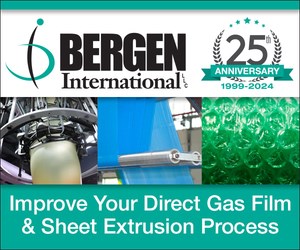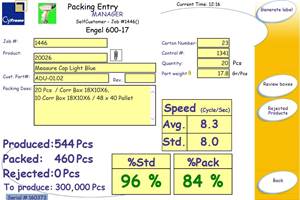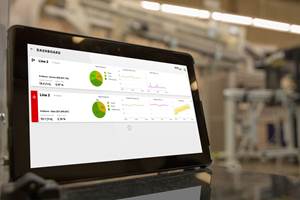There's Plenty of Fizz In Foam Blow Molding
Foam blow molding technology may be taking its first baby steps in the market, but this child could be jogging before long. After at least 10 years of testing, there is just one commercial application, but a score of packaging and industrial projects are being developed, mostly in Europe.
Packaging applications are developing fastest for foam blow molding, justified by opportunities for savings of 10-30% in weight, resin and pigment usage, and cycle time. In relatively thin-wall parts like bottles, the foam cools faster because there's less plastic material present. However, in thicker-walled industrial parts, the foam acts as a heat insulator, extending cycle times and eliminating the productivity advantage.
Despite these encouraging signs, some caution is warranted. "Foam blow molding is still in its infancy. There's quite a bit of interest in it, but only a few firms can make it work currently," says Tom Pontiff, technical director for Clariant Additive Masterbatches in Winchester, Va. His firm, formerly Boehringer Ingelheim (or B.I. Chemicals in the U.S.) before its recent acquisition by Clariant, is a blowing-agent supplier that has been actively developing this technology.
Making it work requires careful attention to technique, and today's know-how may be suitable only for relatively simple shapes. All of the foam bottles now in production or development are monolayer structures. However, patents reportedly have been issued on two- and three-layer foam/solid bottle designs. Virtually all the current activity appears to be with HDPE, though PP is also being tested, as well as nylon and TP elastomers.
Going commercial
The real-life debut of blow molded foam packaging will likely be this month, when Wella AG of Darmstadt, Germany, is expected to start its order for 10 million foamed bottles for its Crisan shampoo line. The 250-cc HDPE bottle will be produced on a proprietary long-stroke, multi-cavity extrusion blow machine designed and built by Alpla Werke in Hard, Austria, which is also making the bottles.
Alpla will be using a new foam concentrate made for the process by Clariant Masterbatches. Just 1.5-2% of the concentrate can foam a 0.960-g/cc HDPE down to 0.78-0.80 g/cc, says Hans Kunz, Alpla's packaging project manager.
Consulting firm Inkutec GmbH of Gotha, Germany, is working with Clariant's foaming agents on a number of projects for bottles, canisters, and technical parts, says Rudolf Fance, managing director. One of these is a 4-liter foamed motor oil container that would be marketed in Hong Kong. Mobil Oil Co., Fairfax, Va., has expressed interest in it, but evaluation of bottle performance and cost issues are ongoing, says a Mobil spokesman. Other projects involve a 2-liter detergent bottle and a mineral-oil canister with a handle (molded by Plasco Ltd. in Hong Kong). Inkutec has had successful test results with canisters up to 30 liters, and one test run of a foamed 220-liter barrel was performed, says Fance.
Reedy International Corp., Keyport, N.J., another foaming-agent supplier, has at least 10 applications in foam blow molding in advanced commercial development, says president Michael Reedy.
Both Clariant and Reedy supply endothermic chemical blowing agents for foam blow molding. Clariant offers two specially formulated products for foam blow molding, Hydrocerol HK40B for PE and HP40P for PP. Both are 40% masterbatches.
Reedy offers Safoam products, including versions that induce long-chain branching in the resin to increase melt strength. The latter reportedly can avoid need for hard-to-process HMW resins.
A different approach comes from Trexel Inc., Woburn, Mass. Its MuCell process is a microcellular foaming technology presently used in extrusion and injection molding and now being extended to blow molding. MuCell involves heating and pressurizing carbon dioxide or nitrogen gas to a supercritical (fluid-like) state in which it readily dissolves in polymer melts. The process reportedly yields uniform closed cells as small as 10 microns. The small cells are said to produce stronger thin-wall parts at reduced densities.
Trexel has test molded a shampoo or cosmetic-type bottle 6 in. high made with 25% density reduction. "We are working with several companies on blow molding applications in the U.S. We hope to have the process in commercial operation by year's end," says Richard Straff, v.p. of research and commercialization.
Industrial foam blow molding applications are developing, too. They include a three-layer, foam-core pallet to be made by BFT Plastics in Northern Ireland with a machine from Krupp Kautex (U.S. offices in Branchburg, N.J.). Inkutec has worked with Hofbauer GmbH in Germany to mold a folding sample case. Inkutec's Fance notes that commercial adoption of foam blow molded auto parts could be announced as early as this month by European car makers.
A delicate process
Most activity with this process has utilized continuous-extrusion machines, though accumulator heads reportedly can also be used. As noted, some of the most advanced projects have used Alpla and Krupp Kautex machines. Inkutec has also worked with machines from Krupp's Fischer-W. Muller Div. (U.S. office in North Branch, N.J.); Uniloy Milacron, Manchester, Mich.; and Bekum (U.S. office in Williamston, Mich.).
Knowledgeable sources agree that the processing window is generally narrower with foam. Two critical steps in foam blow molding are achieving a good mix of foaming agent and polymer, and gentle blowing of the parison into the mold.
"The geometry of the screw is important. It's one development we've invested a lot of money in," says Alpla's Kunz. The firm developed a screw dedicated to foam blow molding. "You absolutely need homogeneous material to get consistent foam," he notes, cautioning that overmixing can create variable foam quality as well.
Clariant sources advise against using screws with shear-mixing elements. They emphasize the importance of avoiding screw designs that allow pressure drops inside the barrel, which can induce pre-blowing. They say the melt must be kept under pressure of at least 1000 psi and recommend grooved feed sections to achieve quick pressure build-up in the barrel.
Reedy says the gas must remain under pressure of at least 750 psi through the die or foam surface problems may result. His firm has developed a special die design to help form a uniform parison while the foam is expanding.
Gentle inflation of the parison in the mold is especially critical. Too much pressure will collapse the foam, leaving a solid part. Alpla's Kunz says his firm blows bottles with less than 44 psi of air pressure--half the standard amount. Clariant's Pontiff recommends vacuum venting on the mold to pull the parison outward more than pushing it with internal air pressure. He says weight reductions of up to 75% are possible with vacuum.
The need for low inflation pressure may restrict the complexity of shapes achievable with foam. However, Pontiff suggests that an exothermic rather than endothermic blowing agent could generate higher foaming pressure to resist collapse during parison inflation.
Related Content
Use Interactive Production Scheduling to Improve Your Plant's Efficiencies
When evaluating ERP solutions, consider the power of interactive production scheduling to effectively plan and allocate primary and secondary equipment, materials and resources on the overall production capacity of the business and conclude that this is a key area that cannot be overlooked.
Read MoreFoam-Core Multilayer Blow Molding: How It’s Done
Learn here how to take advantage of new lightweighting and recycle utilization opportunities in consumer packaging, thanks to a collaboration of leaders in microcellular foaming and multilayer head design.
Read MoreSolve Four Common Problems in PET Stretch-Blow Molding
Here’s a quick guide to fixing four nettlesome problems in processing PET bottles.
Read MoreHow Inline Vision Inspection Can Minimize Scrap in Molding
Once viewed by injection and blow molders as a necessary evil, machine vision technology today can continuously monitor and improve production while reducing costs.
Read MoreRead Next
People 4.0 – How to Get Buy-In from Your Staff for Industry 4.0 Systems
Implementing a production monitoring system as the foundation of a ‘smart factory’ is about integrating people with new technology as much as it is about integrating machines and computers. Here are tips from a company that has gone through the process.
Read MoreFor PLASTICS' CEO Seaholm, NPE to Shine Light on Sustainability Successes
With advocacy, communication and sustainability as three main pillars, Seaholm leads a trade association to NPE that ‘is more active today than we have ever been.’
Read MoreBeyond Prototypes: 8 Ways the Plastics Industry Is Using 3D Printing
Plastics processors are finding applications for 3D printing around the plant and across the supply chain. Here are 8 examples to look for at NPE2024.
Read More





























